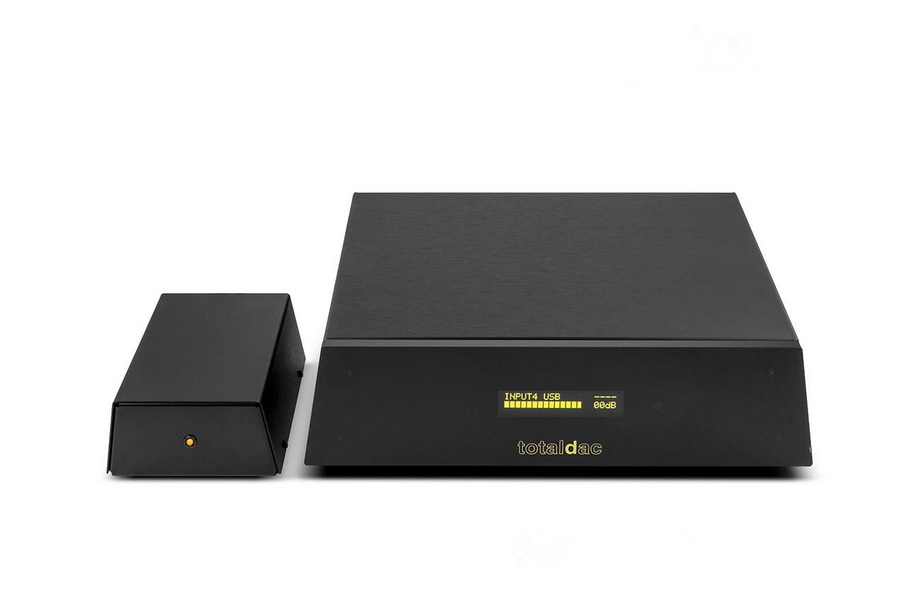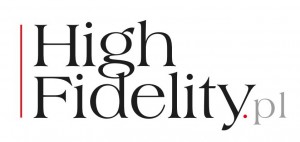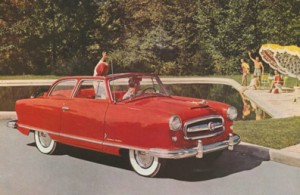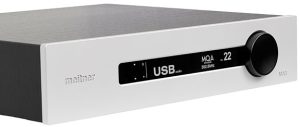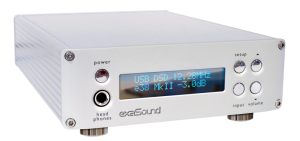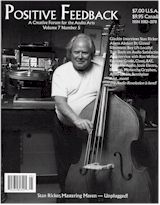Totaldac is a French audio manufacturer, founded in 2010 by Vincent Brient. Its headquarters are located near Mont Saint-Michel, a rocky island in the bay of Mont-Saint-Michel, in the English Channel. The company specializes in digital-to-analog converters and audio file players. It also offers a range of amplifiers, speakers and accessories to improve digital signal reproduction. We test its latest DAC, the d1-unity.
It seems that Vincent Brient, founder, owner and chief engineer of Totaldac, has found his niche. And it really isn't easy to find. He has found it thanks to a clear vision of his products, a converter topology different from classic D/A circuits, a distinctive external design, and a design that allows system expansion from the cheapest model in the unity series, the d1, to the sophisticated four-box d1-sublime (let me remind you that we once tested the three-box d1-twelve model; more HERE).
The creator of Totaldac became involved with audio back when he was a student. As he says, he learned a lot from John Westlake, the man who designed, for example, Pink Triangle's Da Capo DAC, Cambridge Audio's DACMagic and Audiolab's M-DAC. He started with the design of an active digital crossover - by the way, he also offers a product of this type today—and then focused on DACs, before making a smooth transition to transports and audio files players. His current product line also includes loudspeakers and a power amplifier.
As he wrote in an email to Marek Dyba, who tested a d1-dual DAC at one time, he started by testing commercially available chips (test HERE). Since he didn't find anything that guaranteed, in his opinion, high enough sound quality, he decided to develop his own D/A converter circuit. As we read, the result of his work appealed not only to its creator, but also to his friends, hence the idea to found a company.
The distinctive thing about his device was that it was a "discrete" design, that is, built using separate resistors, on an R2R resistor ladder. This is a very different solution to the chips offered by manufacturers such as ESS Technology, Cirrus Logic, and Wolfson Microelectronics. At the time, similar products were offered by EMM Labs, dCS and MSB Technology, and nowadays a number of small manufacturers from China use them as well, such as Denafrips (HERE), Hibiki (HERE) and Jay's Audio (HERE). Japan's Esoteric also has an excellent solution of this type (see the test of the K-01XD SACD player HERE).
In addition to the resistor ladder, an important feature of its products is the absence of oversampling (hence so-called "non-oversampling DAC"). This technique, involves sampling the signal much more frequently than Nyquist theory would suggest, helping to minimize phase distortion and aliasing. Its opponents maintain that it is the cause of unnatural sound. The downside is that in the absence of oversampling, the analog filters in the output start operating earlier than normal, making the signal non-linear (the highs have a lower level than the rest of the band).
And finally, there is the matter of modular design. Any Vincent's DAC can be upgraded to a higher specification at any time. You can also turn it into a full-fledged audio files player, add a headphone amplifier to it, and replace the power supply with a better one.
Therefore, in the "Unity" series we find three, complementary, devices. It opens with, costing €12,500, d1-unity, or the model we are testing. Above there is the d1-triunity, the company's most advanced single-box DAC, with three R2R modules per channel instead of one - we'll pay €24,000 for it. At the very top there is the d1-sublime model. The latter is a device consisting of four boxes: the mono DACs, the signal re-clocking circuitry and a full-size power supply for all of them. The latter, or the top version, will cost you 50.000 euros.
d1-unity
The basic DAC in the "Unity" series, the d1-unity model, has the manufacturer's signature look. The chassis features trapezoidal front and rear walls, with large top and bottom planes and small side ones. The external module is a small power supply. Since the same chassis is shared by all Totaldac products, this reduces the cost of this important component. The front is made of black acrylic, under which a yellow OLED display is placed. On it we can find information about the volume, the selected input and the sampling frequency of the input signal (without bit depth).
The d1-unity works with a discrete DAC of Vincent's idea, the R2R resistor ladder, which consists of one hundred Vishay film resistors per channel (0.01% VAR Bulk Metal). The unit offers a wide range of inputs, including AES/EBU, RCA, Toslink and USB. Interestingly, due to the DAC's limitations, it decodes signals up to 24-bits and 192kHz. Anything above that variance is down-sampled. The DAC can be connected directly to the power amplifier and its volume and balance between channels can be controlled. Volume adjustment is done in the digital domain with a 69-bit DSP chip (previously the chip was 64-bit).
Asked what signals we can send to his converter, Vincent wrote back:
PCM and DSD signals can be sent to the d1-unity. The converter on the digital inputs, including USB, does not accept signals above PCM 24-bits and 192kHz. A control program, such as Roon, can convert them down to this form. The DSD signal is converted internally to a PCM signal, since the R2R resistor ladder is a 24-bit circuit. However, an optional DoP circuit is needed for this. The conversion is handled by a 69-bit FPGA chip. That's why the volume is also changed when the input signal is DSD.
The system is clocked by a clock chip made in-house by Vincent, using a FIFO circuit that minimizes jitter. The unit is powered by an external, linear power supply, to which it connects via a multi-core cable terminated with a multi-pin, screw-on plug. The power supply, too, has a trapezoidal shape housing. Its front panel features an orange light emitting diode.
Owners of d1-unity can count on several additional options:
DoP circuit, that is, the ability to decode the DSD signal sent to any input (350 euros), "bass boost", something for owners of speakers with wideband drivers - an algorithm that increases the amount and intensity of low frequencies (+20% of the price of the DAC), silver aluminum front panel (420 euros),
The DAC tested had a copper plate installed inside the unit to reduce RF and EM interference (430 euros), a power supply for the USB input so that the line is not powered by devices (700 euros),
Two AES/EBU outputs that can be used simultaneously (€350), "live-power" power supply (1200 euros).
On its website, the manufacturer reports that about 150 components have been replaced in the new series, and the analog output stage has been completely revised. By the way, the output voltage of the French company's converters is much higher than the CD Player standard, at 3.5 V for RCA outputs and 7 V for XLR. Yes, there are two types of outputs, as the unit has a balanced design. All these changes, as well as many minor ones, resulted in a new architecture, called Unity by the manufacturer, which gave the name to the whole series:
The "unity" architecture provides more "presence," more contrast between the timbre of each instrument, more contrast between the sizes of the instruments, more clarity, and at the same time more "body" in the sound and higher dynamics; the sound is more realistic and natural, offering more listening pleasure without fatigue.
d1-unity DAC or DAC/streamer, accessed: 25.07.2023.
The manufacturer adds that tuning of the new series was done using an analog tape recorder and "master" tapes as a reference, as well as self-made digital recordings. The listening tests took place in Totaldac's new listening room.
And, finally, two words about the controls. Together with the DAC we also receive a remote control. This is useful, because we will use it to adjust volume and balance between channels, but also to enter the menu of the device. And there we can change the absolute phase, decide whether the power ground is connected to the signal ground, and turn off the display.
You can also choose a digital filter that changes the way the treble is decoded—TREBLE FIR. When "ON" is selected, the device compensates for the treble loss occurring in DACs operating without oversampling. In the "OFF" position, the circuit works as just a NOS (non-oversampling) converter, i.e. with treble reduction.
LISTENING
HOW WE LISTENED
The d1-unity DAC was tested in the High Fidelity reference system and compared to the D/A section of the Ayon Audio CD-35 HF Edition SACD player, which also worked as a transport, and to the Lumin T3 audio files player. As usual, I was most interested in how the DAC handles the CD signal, but this time it was equally important how it worked with the signal sent from the external audio files transport via USB cable.
The Ayon's digital output was connected to the DAC's RCA input with an RCA Acrolink Mexcel 7N-DA6100 II cable, and the Lumin was connected with a TiGLON TPL-2000U cable. The DAC was powered by a Harmonix X-DC350M2R Improved-Version cable. I placed a Verictum X-Block passive EMI/RFI filter on top of the unit.
The Totaldac stood on the top shelf of a Finite Elemente Master Reference Pagode Edition Mk II table on its own feet. In my system I use RCA cables and this is how the DAC was tested. It was connected to the Ayon Audio Spheris III preamplifier by Crystal Cable Absolute Dream cables. However, I separately listened to its XLR output with volume control—the balanced signal was routed directly to the XLR inputs of the Soulution 710 amplifier. However, I preferred the sound with an external preamplifier.
RECORDINGS USED IN THE TEST
COMPACT DISC
Frank Sinatra, Duets II, Capitol Records C2 7243 8 28103 2 2, Reference CD-R (1994).
Radiohead, Kid A, Parlophone/EMI 27753 2, CD (2000).
Stan Levy Sextet, Grand Stan, Bethlehem Records/Toshiba-EMITOCJ-62028, CD (1957/1999).
Rival Sons, Great Western Valkyrie, Erache Records/Hydrant Music QIHC-10059, CD (2014); reviewed HERE.
FILES
Rage Against the Machine, Rage Against the Machine, Epic/Tidal Master, FLAC MQA Studio 24/44.1 (1992/?).
Laura Marling, I Speak Because I Can, Virgin/Tidal, FLAC 16/44.1 (2010/?).
Sault, Untitled (Black Is), Forever Living Originals/Tidal, FLAC 16/44.1 (2020).
Benny Carter, Jazz Giant, Contemporary Records/Tidal Master, FLAC MQA 24/96 (1958/?).
Before I started listening to music, I wanted to see what effect the test DAC's treble compensation had on the sound it offered. To make sense of this, I reached for the Reference CD-R with music released by Frank Sinatra on his latest album, Duets II. The sense in this move was that this disc was recorded on two 24-track analog tape recorders, and the singer was accompanied by a large, even very large big-band orchestra. Such a strong lineup allows one to get a very quick idea of the energy of the upper band and how it integrates with the rest. The class of these recordings, by the way, was recognized by the Grammy Awards jury, honoring it in the Best Traditional Pop Vocal Performance category.
The result of this comparison was not at all conclusive. The orchestra sounded much better, as it was more dynamic and natural in its incredible energy, with the compensation turned on. Also, Sinatra's voice had better carrying capacity with it, more energy and generally sounded better. However, when it came to the women's vocals—let me remind you that this is an album for which Sinatra invited other singing artists—I had my doubts. With Patti Labelle, accompanying him in Bewitched, the compensation was better, i.e. there was more treble. But already with Linda Ronstadt and Moonlight In Vermont it was so obvious.
It may be worth considering this option as a simple way to lower excessive treble energy where it seems appropriate to us. In general. the d1-unity sounds better, after all, when we add treble. And that's because its sound is based on a strong low midrange and upper bass. Withdrawing treble even a little bit slightly blurs the selectivity and edges of the instruments, modifying the dynamics as well. And when dealing with a low voice like Sinatra's—remember he was 77 at the time, and Antonio Carl Jobim's 68—it's better to leave the voice open.
In fact, the same was true of electronic music. Kid A by Radiohead, played through the Totaldac, had a saturated, dense timbre. This is the most important thing for this device. But it was a timbre that was not warmed up or boosted, but simply energetic. Vincent says he reached for a reel-to-reel analog tape recorder when tuning the new series, and it's probably the cause why despite of all the differences between the two—I perceived the d1-unity similarly to how I once perceived my CD-35 High Fidelity Edition player. Totaldac achieves this with its purist methods, while the Ayon does so with its PCM to DSD signal conversion module and tube output.
So both devices play a bit harshly on the one hand, and in an incredibly satisfying way on the other. The French DAC plays a bit lower at the same time, that is, the emphasis is set lower. The distinctive synth sounds of the opening track "In The Right Place" were palpable with it, close to me. It's a thing that repeats itself with all recordings, including the mono recording of the Stan Levy Sextet disc entitled Grand Stan, made in 1957 for Bethlehem Records. The powerful brass section - trumpet, saxophone and trombone—sounded strong and dense.
Perhaps the thing we will pay attention to first and foremost, however, will be the low tones. They are strong and dense. Interestingly, they also have good definition, which is something that the R2R-type multi-bit DACs have problems with, notoriously blurring it. I've already pointed this out with Radiohead, but it was even more apparent now, because this entire album is set low, and that's how the digital remaster, for which Toshiba-EMI was responsible, was made.
As a result, the rhythm of the recordings, their inner pulse was preserved, including when it came to rock recordings. And those with Totaldac sounded very satisfying. I've already talked about Radiohead, but this experimental album, all in all, is based on synthesizer sounds, something that can't be said about the fourth Rival Sons' production entitled Great Western Valkyrie. Stylized after early Led Zeppelin recordings, it sounds in a rather dirty, "analog" way.
The Totaldac managed both in bringing out the clarity and selectivity, and in serving it up in a soft way—the way it was recorded. It was low, there was little selectivity, which is how this record sounds, but everything had its place, nothing lagged behind, nor did I get the impression that the sound was hazy or overly "romantic." The d1-unity sounds a bit like that, but it doesn't drag the strings. It is, while sounding soft, also selective, and while playing warmly, it does not lack energy.
The Rage Against the Machine's debut album, played from files encoded in MQA on Tidal, sounded very pleasant with it. Its opening bass was clear but also dense. Lumin romanticizes everything a bit more and rounds it out. The Totaldac, on the other hand, pulls back some of the higher midrange, resulting in a very pleasant delivery. Yet I didn't feel, at any point, that it was anything reprehensible. It was simply its character.
The soundstage is constructed by this device with dense bodies. Reverberations are an important part of this presentation, but they are less clear than from Lumin or Ayon. The tested DAC is able to organize the presentation, both on the time and dynamic scales, but the nicest part of its mastery of musical matter came out precisely in how it locates information about phantom images on the stage.
For when the band of guitarist Tom Morello and vocalist Zack de la Rocha played, I had a clear picture before me of the image created in the studio. Laura Marling, on the other hand, from the 70s-styled I Speak Because I Can album, sounded like I was sitting in a small jazz club. The guitar had a noticeably longer reverb than the voice, but that's why the guitarist seemed to sit further back than, positioned firmly in front, the singer. This is also a studio recording, and yet the differently applied tools helped to create something completely different.
Such good differentiation in discrete chip-based converters is rare. The dCS devices do well with it, but they don't have something that many of us love this type of devices for saturation. And the d1-unity has both. And this is an exceptionally engaging mix. So it doesn't matter what kind of music you listen to, because it will have natural timbre, and very good rhythmicity every time.
The bass here is strong and dense, with its main energy concentrated in the midrange—the Ayon goes lower and in a more energetic way. But the Ayon is an absolute exception, and the Totaldac compared to it played unruffled, heedless, full in its sound, energetic in its delivery, and above all—let me use the term—musical. Even the specially distorted voice of the singer in Wildfires by Sault didn't bother it, because you could clearly hear what the recording engineer had in mind, and the words were still legible.
Summary
I do remember how much fun I had listening to Totaldac converters from the previous generation. I didn't have them for comparison, but based on my notes I can say that the change brought by the Unity architecture to Vincent Brient's devices is more than just a modification. It's a big step forward in terms of energy and differentiation, and the result of hard work. But it paid off.
For the d1-unity plays warmly, because that's how Vincent conceived it, but also is a differentiating device for recordings. Problems with bass control are a thing of the past, as is the limited clarity of the soundstage. On the one hand, it's still a somewhat "romanticized" sound, but on the other hand, there's none of the melancholy, or romanticism on steroids. The Totaldac plays every kind of music brilliantly, allowing both musicians, sound engineers and recording producers to shine. Congratulations!
DESIGN
All Totaldac devices share the same chassis made of aluminum. They differ only in the planting of the circuit boards inside them and the functions they perform. The enclosures look like low trapezoids, with an acrylic front panel and an aluminum chassis.
FRONT AND REAR
On the front, There is a yellow OLED display, which i indicates the selected input, the input sampling frequency and the volume level—on a bargraph and alphanumerically, in dB, with a level of 0.0 dB in the absence of attenuation. Volume control is performed in the digital domain, in a 69-bit DSP chip. This works very well, but if you want absolutely top-notch sound I would encourage you to use an external, active preamplifier and leave the setting in Totaldac at 0.0dB.
The rear panel is very similar in all the company's devices—they differ only in the way they are cast.
INSIDE
The interior of the device is occupied by two large boards screwed one above the other. On the top one we have resistor ladders with ICs controlling their switching, as well as a large FPGE chip, with the clock placed next to it—this one is enclosed in a screen and additionally clad in copper sheet. This entire section is coupled by a matching transformer to the board below, which houses the power supply and output circuits.
And it is the power supply that takes up the most space. Discrete circuits and many, very nice looking capacitors work in it. You can see that capacitors of different types from different companies have been allocated to different sections. The output circuits are based on discrete transistors and operate in class A. They are assembled on small boards using SMD technique, which makes them resemble Marantz's HDAM circuits and similar NAD solutions. You can see that this is a modular design, so these boards can be replaced with newer ones if needed.
A large copper plate has been screwed to the bottom of the chassis. The unit stands on three, rubber feet, which are worth replacing with decent anti-vibration feet.
POWER SUPPLY
The basis of the power supply is a medium-sized EI transformer, that is, a classic. It was manufactured by the French company Electra Sud-Ouest Fabrique en France (ESO); the company started as early as 1930. A non-rectified voltage of five different values is sent from it. Ferrite bushings have been applied to the power cables, on both sides of the transformer, to minimize high-frequency interference. The power supply stands on four, tiny plastic feet, and you might want to think about putting it on something better.
The remote control was manufactured for Philips. It's a plastic multifunctional controller, not very fitting in appearance to the noble profile of the DAC. But it works, and that's important too.
Technical data (according to the manufacturer)
Accepted digital signal types:
- Asynchronous USB input - PCM up to 24-bits, 192kHz - DSD (DoP option),
- RCA, AES/EBU - PCM up to 24-bits, 192kHz - DSD (DoP option),
- Toslink optical - PCM up to 24 bits, 96 kHz.
- Maximum output voltage: RCA 3.5 Vrms, XLR 7 Vrms (max)
- Power consumption: 14.2 W/44.1 kHz, 16.5 W/192kHz
- Dimensions (H x W x D): DAC 110 x 360 x 290 mm, Power supply 65 x 122 x 180 mm
- Weight: 7 kg
- Price (in Europe): from €12,500
Vincent Brient, Totaldac
MADE IN FRANCE
Provided for the test by: Totaldac
text by WOJCIECH PACUŁA
photos High Fidelity




